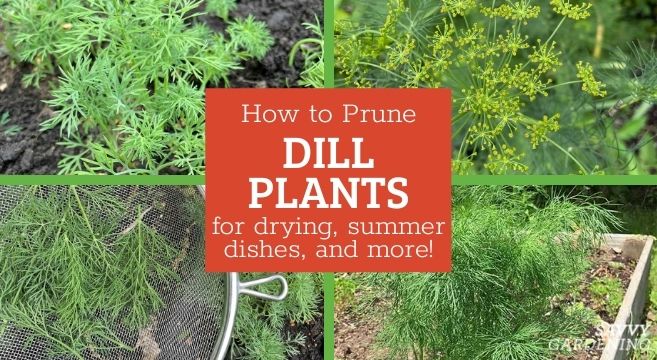This post may contain affiliate links. If you make a purchase through links on our site, we may earn a commission.
Dill is among my favorite herbs I grow in my raised beds, not only because of the delicious harvest, but also because it’s a host plant for black swallowtail caterpillars. Every year they make an appearance! Because I grow so much—or rather, because I let so much dill go to seed—I don’t mind the caterpillars eating it because there is lots to go around. In this article, I’m going to share some tips on how to prune dill for bushier plants, to harvest for eating or drying, to delay flowering, and what to do with the seed heads.
Speaking of the seed heads, they are edible when dried, as are the flowers called umbels that look like yellow fireworks. Dill leaves, or fronds, can be eaten fresh or dried. If you’re looking in the spice aisle, dried dill is often called dill weed and can be used in everything from soups to stews. I love fresh dill in a summer salad.
Growing dill from seed
Dill is one of those herbs that dislikes having its roots disturbed, so it’s best to direct-sow seeds in the garden. You can sometimes find dill plants in pots at the garden center, but they may not take when planted.

If you’d like a continuous harvest, sow seeds from mid-spring (after all threat of frost has passed) to mid-summer in well-draining soil that gets at least six to eight hours of sunlight. If you let your plants go to seed as I do, keep an eye out in the spring for seedlings, and thin as necessary. Keep the area well weeded, so there are no competing plants. That said, my dill grows fairly well around some of the veggies I plant in my raised bed. And it makes a great companion plant for a few vegetables, like tomatoes, peppers and zucchini.
How to prune dill for bushier plants
It may seem counterintuitive to prune a plant that you’re trying to grow to eat, but most herbs benefit from a haircut.
If you use dill regularly, you may be able to skip this step because your frequent harvesting will achieve the same goal of encouraging a bushier plant and delaying blooms. Start pruning your dill when plants are about six to eight inches (15 to 20 centimeters) tall.
To prune, use a pair of herb scissors or even just a regular old pair of scissors and snip the frond-like leaves from the top of the plant, above a leaf set. A good general guideline that you can apply to any herb you’re pruning is to never trim more than one third of the entire plant. And also keep in mind that if you prune down a stem without leaving any fronds (or leaf sets), that stem will not grow more dill.
Be sure to eat whatever you prune off!
With dill, as with other herbs, like cilantro and basil, you also want to delay flowering. Pinching the flower buds can slightly postpone the flower heads from forming.

How to prune dill for recipes and drying
If you need some dill for a garnish or your favorite egg salad recipe, follow the same set of rules outlined above, always making sure you don’t trim down more than one third of the plant.
I snip longer fronds for dill pickles because whole sprigs are easier to fish out than small pieces. Longer stems will also make dill easier to hang and dry.
If you are going to snip dill for drying, keep an eye on the flower buds. The flavor is is strongest right before the plant flowers. Snip long stems and hang upside down in a dark, well-ventilated part of the house. I use gardening twine to hold the bouquet together and a curtain rod to hang. Once the leaves have dried out completely, store your dry dill in an airtight container in a dark cupboard.

Once the herb starts to flower, the fronds aren’t as plentiful, or flavorful, for that matter. Slow-to-bolt varieties, like the All-America Selections winner Fernleaf Dill, can delay the flowers more than other types.
How to prune dill seed heads
Once those yellow dill flowers start to dry out, they’ll eventually form a TON of seeds. I like to let some fall in the garden, but I also save the seeds. If you’re not interested in your dill self-seeding, be sure to remove the seed heads. This article explains how to collect dill seeds for cooking or to plant next year.

More herb-growing tips and advice
- Planting cilantro seeds in the garden
- Tips for harvesting homegrown herbs
- How to harvest fresh oregano
- Grow basil plants from seed




I discovered that caterpillars like dill a little too late!
I was enjoying snipping it and cooking with it, when one day I noticed the eggs.
I’m pretty sure I ate a lot of them when they were smaller. I left the dill to them after that and still got a good number of caterpillars.